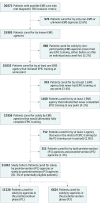Association of Statewide Implementation of the Prehospital Traumatic Brain Injury Treatment Guidelines With Patient Survival Following Traumatic Brain Injury: The Excellence in Prehospital Injury Care (EPIC) Study
- PMID: 31066879
- PMCID: PMC6506902
- DOI: 10.1001/jamasurg.2019.1152
Association of Statewide Implementation of the Prehospital Traumatic Brain Injury Treatment Guidelines With Patient Survival Following Traumatic Brain Injury: The Excellence in Prehospital Injury Care (EPIC) Study
Abstract
Importance: Traumatic brain injury (TBI) is a massive public health problem. While evidence-based guidelines directing the prehospital treatment of TBI have been promulgated, to our knowledge, no studies have assessed their association with survival.
Objective: To evaluate the association of implementing the nationally vetted, evidence-based, prehospital treatment guidelines with outcomes in moderate, severe, and critical TBI.
Design, setting, and participants: The Excellence in Prehospital Injury Care (EPIC) Study included more than 130 emergency medical services systems/agencies throughout Arizona. This was a statewide, multisystem, intention-to-treat study using a before/after controlled design with patients with moderate to critically severe TBI (US Centers for Disease Control and Prevention Barell Matrix-Type 1 and/or Abbreviated Injury Scale Head region severity ≥3) transported to trauma centers between January 1, 2007, and June 30, 2015. Data were analyzed between October 25, 2017, and February 22, 2019.
Interventions: Implementation of the prehospital TBI guidelines emphasizing avoidance/treatment of hypoxia, prevention/correction of hyperventilation, and avoidance/treatment of hypotension.
Main outcomes and measures: Primary: survival to hospital discharge; secondary: survival to hospital admission.
Results: Of the included patients, the median age was 45 years, 14 666 (67.1%) were men, 7181 (32.9%) were women; 16 408 (75.1% ) were white, 1400 (6.4%) were Native American, 743 (3.4% ) were Black, 237 (1.1%) were Asian, and 2791 (12.8%) were other race/ethnicity. Of the included patients, 21 852 met inclusion criteria for analysis (preimplementation phase [P1]: 15 228; postimplementation [P3]: 6624). The primary analysis (P3 vs P1) revealed an adjusted odds ratio (aOR) of 1.06 (95% CI, 0.93-1.21; P = .40) for survival to hospital discharge. The aOR was 1.70 (95% CI, 1.38-2.09; P < .001) for survival to hospital admission. Among the severe injury cohorts (but not moderate or critical), guideline implementation was significantly associated with survival to discharge (Regional Severity Score-Head 3-4: aOR, 2.03; 95% CI, 1.52-2.72; P < .001; Injury Severity Score 16-24: aOR, 1.61; 95% CI, 1.07-2.48; P = .02). This was also true for survival to discharge among the severe, intubated subgroups (Regional Severity Score-Head 3-4: aOR, 3.14; 95% CI, 1.65-5.98; P < .001; Injury Severity Score 16-24: aOR, 3.28; 95% CI, 1.19-11.34; P = .02).
Conclusions and relevance: Statewide implementation of the prehospital TBI guidelines was not associated with significant improvement in overall survival to hospital discharge (across the entire, combined moderate to critical injury spectrum). However, adjusted survival doubled among patients with severe TBI and tripled in the severe, intubated cohort. Furthermore, guideline implementation was significantly associated with survival to hospital admission. These findings support the widespread implementation of the prehospital TBI treatment guidelines.
Trial registration: ClinicalTrials.gov identifier: NCT01339702.
Conflict of interest statement
Figures



Similar articles
-
[Prehospital care of pediatric traumatic brain injury].Med Klin Intensivmed Notfmed. 2023 Nov;118(8):626-637. doi: 10.1007/s00063-023-01046-3. Epub 2023 Jul 14. Med Klin Intensivmed Notfmed. 2023. PMID: 37450022 Review. German.
-
EMS Treatment Guidelines in Major Traumatic Brain Injury With Positive Pressure Ventilation.JAMA Surg. 2024 Apr 1;159(4):363-372. doi: 10.1001/jamasurg.2023.7155. JAMA Surg. 2024. PMID: 38265782 Free PMC article.
-
Effect of Implementing the Out-of-Hospital Traumatic Brain Injury Treatment Guidelines: The Excellence in Prehospital Injury Care for Children Study (EPIC4Kids).Ann Emerg Med. 2021 Feb;77(2):139-153. doi: 10.1016/j.annemergmed.2020.09.435. Epub 2020 Nov 11. Ann Emerg Med. 2021. PMID: 33187749 Free PMC article.
-
Adverse Prehospital Events and Outcomes After Traumatic Brain Injury.JAMA Netw Open. 2025 Jan 2;8(1):e2457506. doi: 10.1001/jamanetworkopen.2024.57506. JAMA Netw Open. 2025. PMID: 39888614 Free PMC article.
-
Prehospital care for traumatic brain injuries: A review of U.S. state emergency medical services protocols.Am J Emerg Med. 2024 Oct;84:158-161. doi: 10.1016/j.ajem.2024.07.063. Epub 2024 Aug 5. Am J Emerg Med. 2024. PMID: 39128170 Review.
Cited by
-
[Prehospital care of pediatric traumatic brain injury].Med Klin Intensivmed Notfmed. 2023 Nov;118(8):626-637. doi: 10.1007/s00063-023-01046-3. Epub 2023 Jul 14. Med Klin Intensivmed Notfmed. 2023. PMID: 37450022 Review. German.
-
Civilian gunshot wounds to the head: a case report, clinical management, and literature review.Chin Neurosurg J. 2021 Feb 3;7(1):12. doi: 10.1186/s41016-020-00227-9. Chin Neurosurg J. 2021. PMID: 33531086 Free PMC article.
-
Association of Prehospital Plasma With Survival in Patients With Traumatic Brain Injury: A Secondary Analysis of the PAMPer Cluster Randomized Clinical Trial.JAMA Netw Open. 2020 Oct 1;3(10):e2016869. doi: 10.1001/jamanetworkopen.2020.16869. JAMA Netw Open. 2020. PMID: 33057642 Free PMC article. Clinical Trial.
-
Changes in neurologic status after traumatic brain injury in the Resuscitation Outcomes Consortium Hypertonic Saline trial.J Am Coll Emerg Physicians Open. 2024 Mar 14;5(2):e13107. doi: 10.1002/emp2.13107. eCollection 2024 Apr. J Am Coll Emerg Physicians Open. 2024. PMID: 38486833 Free PMC article.
-
Identification of Demographic and Clinical Prognostic Factors in Traumatic Intraventricular Hemorrhage.Neurocrit Care. 2023 Feb;38(1):149-157. doi: 10.1007/s12028-022-01587-z. Epub 2022 Sep 1. Neurocrit Care. 2023. PMID: 36050537 Free PMC article. Review.
References
-
- Bell JMBM, Jenkins EL, Haarbauer-Krupa J. Traumatic Brain Injury In the United States: Epidemiology and Rehabilitation. Washington, DC: National Center for Injury Prevention and Control, Division of Unintentional Injury Prevention, Centers for Disease Control; 2014.
-
- Finkelstein E, Corso PS, Miller TR. The Incidence and Economic Burden of Injuries in the United States. New York, NY: Oxford University Press; 2006. doi:10.1093/acprof:oso/9780195179484.001.0001 - DOI
Publication types
MeSH terms
Associated data
Grants and funding
LinkOut - more resources
Full Text Sources
Medical
Miscellaneous

